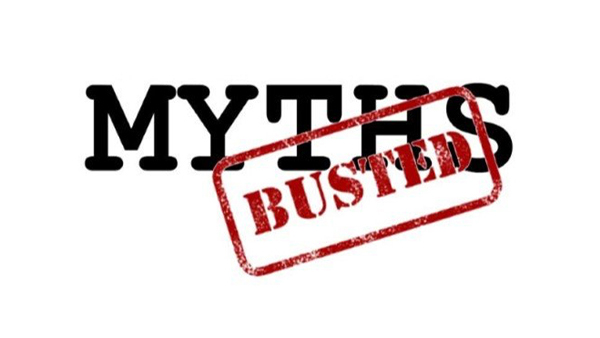There’s an awful lot of false and misleading information about Coronavirus circulating on social media and in the press, so we’re busting some of those myths!
Myth: No-one has to go to work except for key workers
Fact: Government instruction is that you may leave your house if you are travelling to and from work, but only where this absolutely cannot be done at home
There has been a Twitter post circulated from 10 Downing Street stating only key workers need to go to work. This post has now been amended, but it has already reached a massive audience.
Certain businesses MUST close – including non-essential shops, libraries, community centres, leisure facilities, playgrounds, places of worship, hotels, b&bs, campsites and caravan parks, but it does not state that All businesses must close.
If your employees CAN work from home, you MUST allow them to do so (you could end up with a fine or an enforced closure if you don’t allow them to), but if they can’t then they should still come to work.
You may want to give your employees a letter explaining why they cannot work from home, just in case they get stopped on their way to or from work.
You must ensure social distancing rules are followed in the workplace, ensuring employees are keeping 2m apart.
Full guidance on the latest update can be found here
Myth: I can claim 80% of my employees wages and still have them working, or pay them holiday pay, or reduce their hours
FACT: Furlough means NO WORK, NO PAY
To reclaim the 80% wage, you must place your employees on furlough. They cannot work for you during this time. Any employees who are still working (regardless of hours) are NOT on furlough and are not eligible.
Read the full guidance here
Myth: I have to top up the other 20% of furloughed employees’ wages
FACT: You may choose to, but you don’t have to
Good communication with your employees is key here.
Read the full guidance here
Myth: Employees can request to be put on furlough if they don’t want to come into work
FACT: Furlough is a decision taken by the company when there is NO WORK available and the company cannot pay employees. Employees have NO right to request furlough as an alternative to attending work
Placing an employee on furlough because they simply don’t want come to work would make them ineligible for the Coronavirus Job Retention Scheme as work is still available to them.
Reassure your employees that you are doing all you can to mitigate risks and that they are still expected to attend work.
Employees who are shielding in line with government recommendation, or who have care issues as a result of Coronavirus (such as childcare issues), can be furloughed, but for all other employees non-attendance may be treated as a disciplinary matter.
Myth: I’ve already started the redundancy process so I can’t go back on this now
FACT: A key part of redundancy consultations is looking at ways to avoid redundancy. Furlough would be an acceptable way to avoid redundancy.
Call your employee in to a formal consultation meeting and offer them furlough as a suitable alternative to redundancy. You can then confirm this in writing.
This does not stop you from carrying out a redundancy process later down the line if it becomes necessary.
Myth: I have to pay contractual sick pay for those who are isolating
FACT: If you have a company sick pay scheme, for those who are displaying symptoms themselves you will need to pay company sick pay.
For those who are self-isolating because someone else in their household has symptoms you do not need to pay company sick pay, but you may choose to do so.
Myth: Employees who are absent due to childcare issues can claim SSP or be put on furlough
FACT: Unless they are self-isolating, or there is no work available for them in the workplace, employees with childcare duties are not entitled to SSP.
But they can be furloughed, although you are within your rights to refuse this if it is operationally difficult.
Myth: Vulnerable employees must self-isolate for 12 weeks and can claim SSP or be put on furlough
FACT: Any vulnerable people that have received a letter from the NHS telling them to shield can be placed on furlough, or SSP
But unless they have received this letter, you are not obligated to furlough them, although you should give due consideration to their request and try to assist where possible.
Myth: Employees will lose any holiday they can’t take this year
FACT: Up to 4 weeks of annual leave can be carried forward into the next two leave years
with the remaining 1.6 weeks being carried forward into the next leave year.
Myth: I have to rehire anyone who has left the company since 19th March 2020
FACT: You may choose to re-hire employees who are now eligible for furlough, but you don’t have to
Make sure you explain to them the reason why you cannot rehire them.
Myth: I can furlough an employee for a week, then return them to work
FACT: Furlough is for a minimum of 3 weeks
You can return employees to work after this 3 week period, and you may place them on furlough again, but each period of furlough must be for a minimum of 3 weeks.
Myth: I have to put the whole company on furlough
FACT: You can select individuals to furlough
But you must make sure you follow a fair selection process. Many businesses are choosing to furlough some employees, then return them to work after three weeks and furlough the other employees so as to make it fair and equal.
Myth: Employees on sick leave, maternity leave or other statutory leaves must be furloughed
FACT: You should continue with any statutory payments and leave arrangements
You can then furlough them when they are due to return to work.
Myth: The Coronavirus Job Retention Scheme will pay out on company cars, commissions and bonuses
FACT: It depends on what your employees’ contract of employment says
Payments that are non-discretionary (i.e. contractual) should still be made and can be reclaimed, but any discretionary payments can’t be.
Myth: Only those on fixed hours can be furloughed
FACT: Furlough applies to most employees
full time, part time, agency workers or zero/casual workers. For workers with irregular hours you can use the higher of the same month’s earnings last year, or the average earnings for the 2019-20 tax year, or a pro-rate of their earnings to date if they’ve not been with you for a year.




